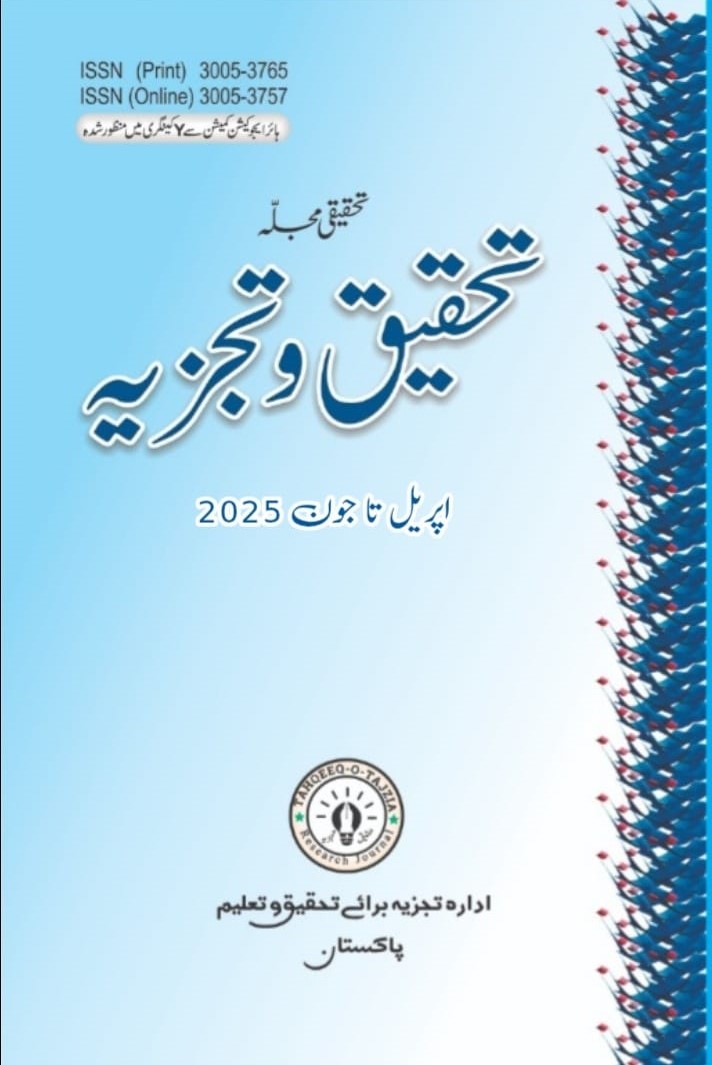Allegory and Accustomed Urdu Fables by Asope: A Research and Critical Review
Keywords:
Allegory, symbolic narrative, fables, , parables metaphor,Asope, , nonhuman characterscommon heritage, common heritageAbstract
In literature Allegory is a symbolic narrative that serves as a veil for the deeper meanings that lies beneath the surface meanings. Fable is its distinguish form which describe the story with a moral lesson by nonhuman characters, if a story deals with the animals or other natural objects who behave like the humans, it’s an ‘’Allegory, Fable’’. The characters in a Fable are not usually individual personalities, but rather embody moral qualities and other entities .Allegory is closely related to parables, fables, and metaphor but it differs from each other in complexity , length and treatment. When a story or figure contains a meaning that is parallel , additional, or clearly distinct from the literal meaning it’s an Allegory. Asope is the most important and prominent figure in
world literature by his Fables. From ancient age Fables were travelling with human history but Asope transformed the short and meaningful tales in the form of art and used nature and nonhuman characters as subjects of dual meaning to describe social and human situations. These Fables reflects collective human situations and attitudes. These Fables are the common heritage of humanity so as other literary cultures and traditions Urdu language and literature is also benefited by Asope’s Allegories .In this article, Allegory and Asope’s Allegories have been discussed specifically so that its literary status and value could be reveal and clarified.
References:
- Jain, Dr. Gyan Chand. Tahreerain. Lucknow: Dara-e-Farogh-e-Urdu, 1964, pp. 269–270.
- "Allos and Allegorevein", from English terminology, used in literary analysis.
- Oxford English Dictionary, https://www.oed.com
- Wikipedia, https://www.wikipedia.org
- The Columbia Encyclopedia, Vol. 08, 6th Edition. Visible Ink Press, June 2000, p. 52.
- Jain, Dr. Gyan Chand. Tahreerain, p. 27.
- Chambers Encyclopedia, cited in: Azmi, Manzar. Urdu Mein Tamseel Nigari. Delhi: Anjuman Taraqqi Urdu, 1992, p. 45.
- Sandeelvi, Salam. Adabi Isharay. Naseem Book Depot, Lucknow, 1961, p. 35.
- Masiḥ al-Zamā Adabi Ziney. Asrar Karimi Press, Allahabad, India, 1956, p. 111.
- Azmi, Manzar. Urdu Mein Tamseel Nigari ki Riwayat. Delhi: Anjuman Taraqqi Urdu, 1992, p. 55.
- Writer’s Digest, https://www.writersdigest.com
- Encyclopedia Britannica, https://www.britanica.com
- Encyclopedia Britannica, https://www.britanica.com
- Jain, Gyan Chand. Urdu Ki Nasri Dastanain. Lucknow: Uttar Pradesh Urdu Academy, 1987, p. 14.
Bibliography
Azmi, Manzar. Urdu Mein Tamseel Nigari ki Riwayat. Delhi: Anjuman Taraqqi Urdu, 1992.
Chambers Encyclopedia. Cited in Manzar Azmi, Urdu Mein Tamseel Nigari. Delhi: Anjuman Taraqqi Urdu, 1992.
Columbia Encyclopedia. Vol. 08, 6th ed., Visible Ink Press, June 2000.
Encyclopedia Britannica. https://www.britanica.com
Jain, Gyan Chand. Tahreerain. Lucknow: Dara-e-Farogh-e-Urdu, 1964.
Jain, Gyan Chand. Urdu Ki Nasri Dastanain. Lucknow: Uttar Pradesh Urdu Academy, 1987.
Masiḥ al-Zamān. Adabi Ziney. Allahabad: Asrar Karimi Press, 1956.
Oxford English Dictionary. https://www.oed.com
Sandeelvi, Salam. Adabi Isharay. Lucknow: Naseem Book Depot, 1961.
Wikipedia. https://www.wikipedia.org
Writer’s Digest. https://www.writersdigest.com
Downloads





